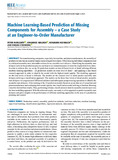Citation link:
http://dx.doi.org/10.25819/ubsi/10134| DC Field | Value | Language |
|---|---|---|
| crisitem.author.orcid | 0000-0001-9018-9959 | - |
| crisitem.author.orcid | 0000-0002-2552-2855 | - |
| dc.contributor.author | Steinberg, Fabian | - |
| dc.contributor.author | Burggräf, Peter | - |
| dc.contributor.author | Wagner, Johannes | - |
| dc.contributor.author | Heinbach, Benjamin | - |
| dc.date.accessioned | 2022-06-09T07:56:09Z | - |
| dc.date.available | 2022-06-09T07:56:09Z | - |
| dc.date.issued | 2021 | de |
| dc.description | Finanziert aus dem Open-Access-Publikationsfonds der Universität Siegen für Zeitschriftenartikel | de |
| dc.description.abstract | For manufacturing companies, especially for machine and plant manufacturers, the assembly of products in time has an essential impact on meeting delivery dates. Often missing individual components lead to a delayed assembly start, hereinafter referred to as assembly start delayers. Identifying the assembly start delayers early in the production process can help to set countermeasures to meet the required delivery dates. In order to achieve this, we set up 24 prediction models on four different levels of detail utilizing different machine learning-algorithms - six prediction models on every level of detail - and applying a case-based research approach in order to identify the model with the highest model quality. The modeling approach on the four levels of detail is different. The models on the coarsest level of detail predict assembly start delayers utilizing a classification approach. The models on the three finer levels of detail predict assembly start delayers via a regression of different lead times and subsequent postprocessing operations to identify the assembly start delayers. After training of the 24 prediction models based on a real data set of a machine and plant manufacturer and evaluating their model quality, the classification model utilizing a Gradient Boosting classifier showed best results. Thus, performing a binary classification to identify assembly start delayers was the best modelling approach. With the achieved results, our study is a first approach to predict assembly start delayers and gives insights in the performance of different modeling approaches in the area of a production planning and control. | en |
| dc.identifier.doi | http://dx.doi.org/10.25819/ubsi/10134 | - |
| dc.identifier.uri | https://dspace.ub.uni-siegen.de/handle/ubsi/2223 | - |
| dc.identifier.urn | urn:nbn:de:hbz:467-22235 | - |
| dc.language.iso | en | de |
| dc.source | IEEE Access ; Vol. 9 (2021), S. 105926-105938. - https://dx.doi.org/10.1109/ACCESS.2021.3075620 | de |
| dc.subject.ddc | 620 Ingenieurwissenschaften und zugeordnete Tätigkeiten | de |
| dc.subject.other | Production control | en |
| dc.subject.other | Assembly | en |
| dc.subject.other | Prediction methods | en |
| dc.subject.other | Lead time reduction | en |
| dc.subject.other | Machine learning | en |
| dc.subject.other | Supervised learning | en |
| dc.subject.other | Classification algorithms | en |
| dc.subject.other | Regression analysis | en |
| dc.subject.other | Data analysis | en |
| dc.subject.other | Produktionssteuerung | de |
| dc.subject.other | Montage | de |
| dc.subject.other | Vorhersagemethoden | de |
| dc.subject.other | Reduzierung der Durchlaufzeit | de |
| dc.subject.other | Maschinelles Lernen | de |
| dc.subject.other | Überwachtes Lernen | de |
| dc.subject.other | Algorithmen zur Klassifizierung | de |
| dc.subject.other | Regressionsanalyse | de |
| dc.subject.other | Datenanalyse | de |
| dc.subject.swb | Produktionssteuerung | de |
| dc.subject.swb | Prognose | de |
| dc.subject.swb | Maschinelles Lernen | de |
| dc.subject.swb | Regressionsanalyse | de |
| dc.title | Machine learning-based prediction of missing components for assembly - a case study at an engineer-to-order manufacturer | en |
| dc.type | Article | de |
| item.fulltext | With Fulltext | - |
| ubsi.publication.affiliation | Department Maschinenbau | de |
| ubsi.source.doi | 10.1109/ACCESS.2021.3075620 | - |
| ubsi.source.issn | 2169-3536 | - |
| ubsi.source.issued | 2021 | de |
| ubsi.source.issuenumber | 9 | de |
| ubsi.source.pagefrom | 105926 | de |
| ubsi.source.pageto | 105938 | de |
| ubsi.source.place | New York | de |
| ubsi.source.publisher | IEEE | de |
| ubsi.source.title | IEEE Access | de |
| ubsi.subject.ghbs | ZHX | de |
| Appears in Collections: | Geförderte Open-Access-Publikationen | |
Files in This Item:
| File | Description | Size | Format | |
|---|---|---|---|---|
| Machine_learning-based_prediction_of_missing_components_for_assembly.pdf | 5.85 MB | Adobe PDF |  View/Open |
This item is protected by original copyright |
Page view(s)
327
checked on Nov 25, 2024
Download(s)
152
checked on Nov 25, 2024
Google ScholarTM
Check
Altmetric
Items in DSpace are protected by copyright, with all rights reserved, unless otherwise indicated.

